Management Style and Principles of Ken Murphy in Tesco
VerifiedAdded on 2022/12/29
|10
|3576
|1
AI Summary
This report analyzes the management style and principles of Ken Murphy, the CEO of Tesco, and their impact on the organizational structure, culture, and employee motivation. It also discusses the use of power, influence, and conflict resolution in Tesco and provides recommendations for improving organizational performance.
Contribute Materials
Your contribution can guide someone’s learning journey. Share your
documents today.
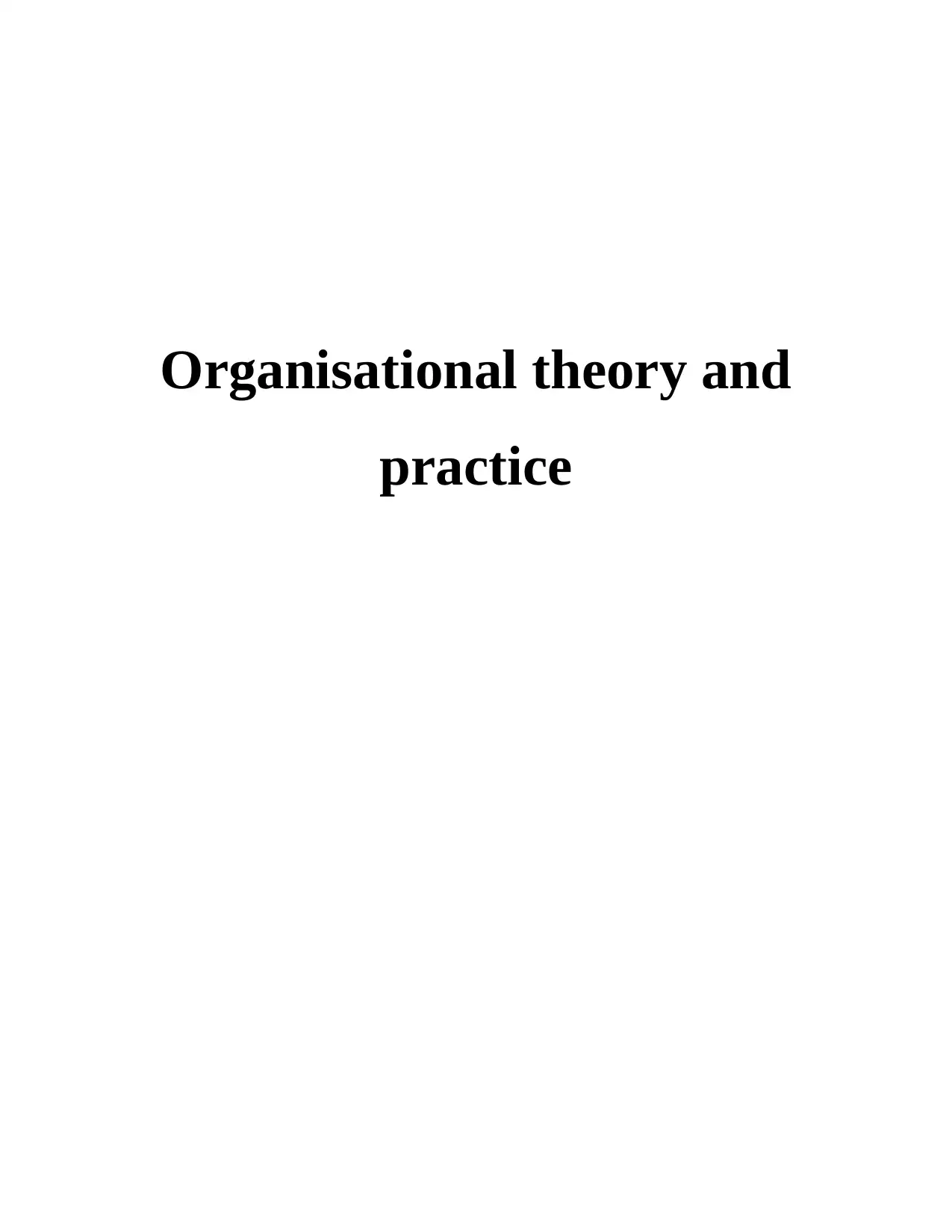
Organisational theory and
practice
practice
Secure Best Marks with AI Grader
Need help grading? Try our AI Grader for instant feedback on your assignments.
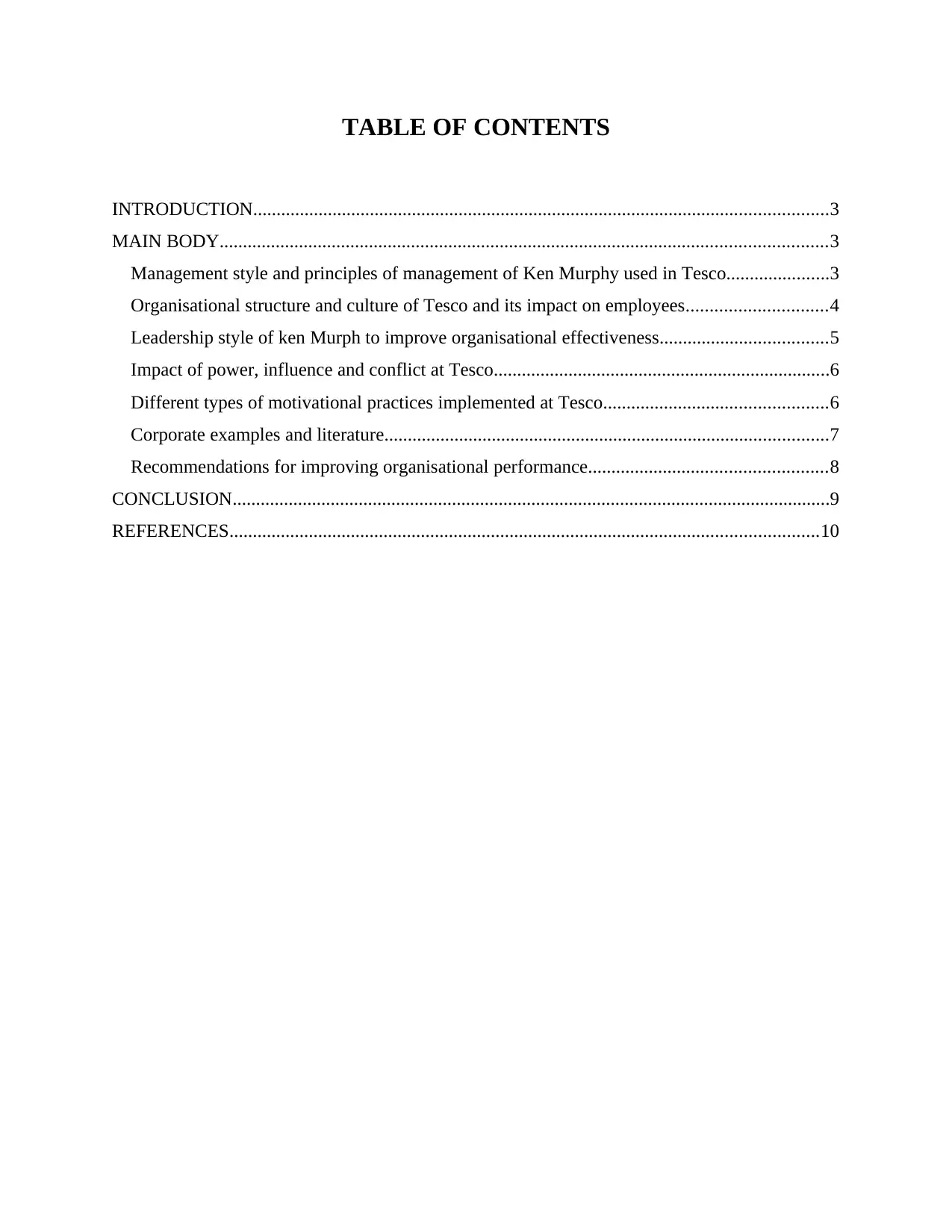
TABLE OF CONTENTS
INTRODUCTION...........................................................................................................................3
MAIN BODY..................................................................................................................................3
Management style and principles of management of Ken Murphy used in Tesco......................3
Organisational structure and culture of Tesco and its impact on employees..............................4
Leadership style of ken Murph to improve organisational effectiveness....................................5
Impact of power, influence and conflict at Tesco........................................................................6
Different types of motivational practices implemented at Tesco................................................6
Corporate examples and literature...............................................................................................7
Recommendations for improving organisational performance...................................................8
CONCLUSION................................................................................................................................9
REFERENCES..............................................................................................................................10
INTRODUCTION...........................................................................................................................3
MAIN BODY..................................................................................................................................3
Management style and principles of management of Ken Murphy used in Tesco......................3
Organisational structure and culture of Tesco and its impact on employees..............................4
Leadership style of ken Murph to improve organisational effectiveness....................................5
Impact of power, influence and conflict at Tesco........................................................................6
Different types of motivational practices implemented at Tesco................................................6
Corporate examples and literature...............................................................................................7
Recommendations for improving organisational performance...................................................8
CONCLUSION................................................................................................................................9
REFERENCES..............................................................................................................................10
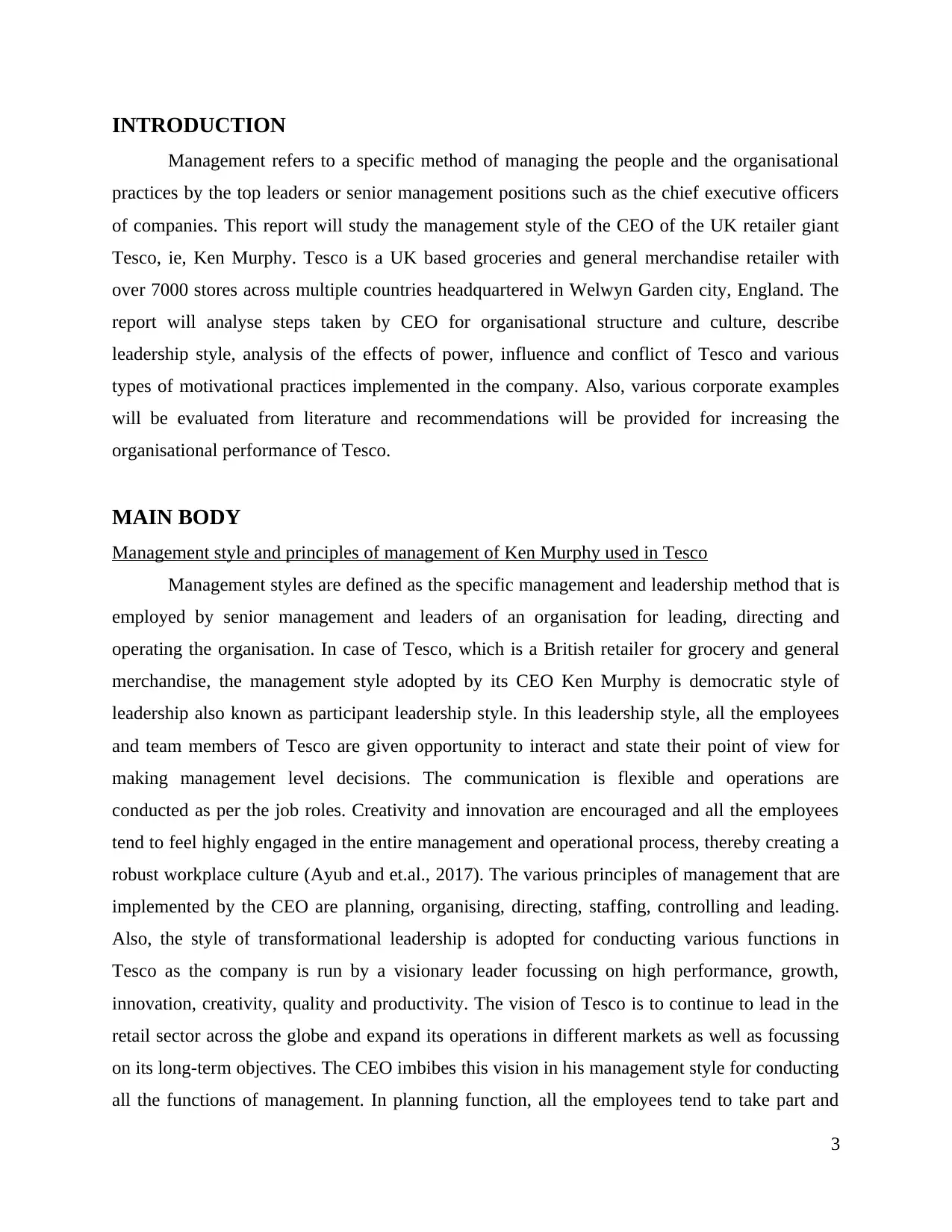
INTRODUCTION
Management refers to a specific method of managing the people and the organisational
practices by the top leaders or senior management positions such as the chief executive officers
of companies. This report will study the management style of the CEO of the UK retailer giant
Tesco, ie, Ken Murphy. Tesco is a UK based groceries and general merchandise retailer with
over 7000 stores across multiple countries headquartered in Welwyn Garden city, England. The
report will analyse steps taken by CEO for organisational structure and culture, describe
leadership style, analysis of the effects of power, influence and conflict of Tesco and various
types of motivational practices implemented in the company. Also, various corporate examples
will be evaluated from literature and recommendations will be provided for increasing the
organisational performance of Tesco.
MAIN BODY
Management style and principles of management of Ken Murphy used in Tesco
Management styles are defined as the specific management and leadership method that is
employed by senior management and leaders of an organisation for leading, directing and
operating the organisation. In case of Tesco, which is a British retailer for grocery and general
merchandise, the management style adopted by its CEO Ken Murphy is democratic style of
leadership also known as participant leadership style. In this leadership style, all the employees
and team members of Tesco are given opportunity to interact and state their point of view for
making management level decisions. The communication is flexible and operations are
conducted as per the job roles. Creativity and innovation are encouraged and all the employees
tend to feel highly engaged in the entire management and operational process, thereby creating a
robust workplace culture (Ayub and et.al., 2017). The various principles of management that are
implemented by the CEO are planning, organising, directing, staffing, controlling and leading.
Also, the style of transformational leadership is adopted for conducting various functions in
Tesco as the company is run by a visionary leader focussing on high performance, growth,
innovation, creativity, quality and productivity. The vision of Tesco is to continue to lead in the
retail sector across the globe and expand its operations in different markets as well as focussing
on its long-term objectives. The CEO imbibes this vision in his management style for conducting
all the functions of management. In planning function, all the employees tend to take part and
3
Management refers to a specific method of managing the people and the organisational
practices by the top leaders or senior management positions such as the chief executive officers
of companies. This report will study the management style of the CEO of the UK retailer giant
Tesco, ie, Ken Murphy. Tesco is a UK based groceries and general merchandise retailer with
over 7000 stores across multiple countries headquartered in Welwyn Garden city, England. The
report will analyse steps taken by CEO for organisational structure and culture, describe
leadership style, analysis of the effects of power, influence and conflict of Tesco and various
types of motivational practices implemented in the company. Also, various corporate examples
will be evaluated from literature and recommendations will be provided for increasing the
organisational performance of Tesco.
MAIN BODY
Management style and principles of management of Ken Murphy used in Tesco
Management styles are defined as the specific management and leadership method that is
employed by senior management and leaders of an organisation for leading, directing and
operating the organisation. In case of Tesco, which is a British retailer for grocery and general
merchandise, the management style adopted by its CEO Ken Murphy is democratic style of
leadership also known as participant leadership style. In this leadership style, all the employees
and team members of Tesco are given opportunity to interact and state their point of view for
making management level decisions. The communication is flexible and operations are
conducted as per the job roles. Creativity and innovation are encouraged and all the employees
tend to feel highly engaged in the entire management and operational process, thereby creating a
robust workplace culture (Ayub and et.al., 2017). The various principles of management that are
implemented by the CEO are planning, organising, directing, staffing, controlling and leading.
Also, the style of transformational leadership is adopted for conducting various functions in
Tesco as the company is run by a visionary leader focussing on high performance, growth,
innovation, creativity, quality and productivity. The vision of Tesco is to continue to lead in the
retail sector across the globe and expand its operations in different markets as well as focussing
on its long-term objectives. The CEO imbibes this vision in his management style for conducting
all the functions of management. In planning function, all the employees tend to take part and
3
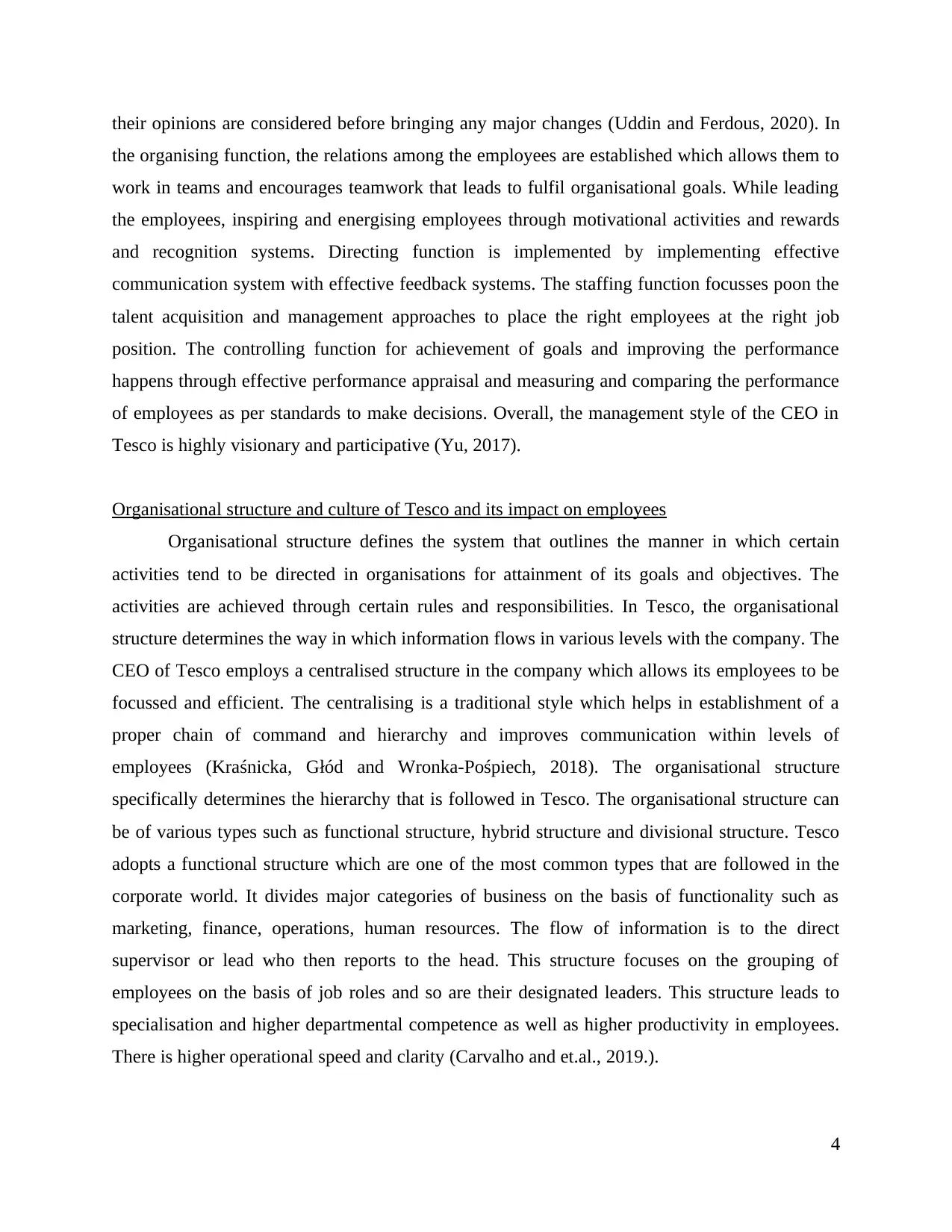
their opinions are considered before bringing any major changes (Uddin and Ferdous, 2020). In
the organising function, the relations among the employees are established which allows them to
work in teams and encourages teamwork that leads to fulfil organisational goals. While leading
the employees, inspiring and energising employees through motivational activities and rewards
and recognition systems. Directing function is implemented by implementing effective
communication system with effective feedback systems. The staffing function focusses poon the
talent acquisition and management approaches to place the right employees at the right job
position. The controlling function for achievement of goals and improving the performance
happens through effective performance appraisal and measuring and comparing the performance
of employees as per standards to make decisions. Overall, the management style of the CEO in
Tesco is highly visionary and participative (Yu, 2017).
Organisational structure and culture of Tesco and its impact on employees
Organisational structure defines the system that outlines the manner in which certain
activities tend to be directed in organisations for attainment of its goals and objectives. The
activities are achieved through certain rules and responsibilities. In Tesco, the organisational
structure determines the way in which information flows in various levels with the company. The
CEO of Tesco employs a centralised structure in the company which allows its employees to be
focussed and efficient. The centralising is a traditional style which helps in establishment of a
proper chain of command and hierarchy and improves communication within levels of
employees (Kraśnicka, Głód and Wronka-Pośpiech, 2018). The organisational structure
specifically determines the hierarchy that is followed in Tesco. The organisational structure can
be of various types such as functional structure, hybrid structure and divisional structure. Tesco
adopts a functional structure which are one of the most common types that are followed in the
corporate world. It divides major categories of business on the basis of functionality such as
marketing, finance, operations, human resources. The flow of information is to the direct
supervisor or lead who then reports to the head. This structure focuses on the grouping of
employees on the basis of job roles and so are their designated leaders. This structure leads to
specialisation and higher departmental competence as well as higher productivity in employees.
There is higher operational speed and clarity (Carvalho and et.al., 2019.).
4
the organising function, the relations among the employees are established which allows them to
work in teams and encourages teamwork that leads to fulfil organisational goals. While leading
the employees, inspiring and energising employees through motivational activities and rewards
and recognition systems. Directing function is implemented by implementing effective
communication system with effective feedback systems. The staffing function focusses poon the
talent acquisition and management approaches to place the right employees at the right job
position. The controlling function for achievement of goals and improving the performance
happens through effective performance appraisal and measuring and comparing the performance
of employees as per standards to make decisions. Overall, the management style of the CEO in
Tesco is highly visionary and participative (Yu, 2017).
Organisational structure and culture of Tesco and its impact on employees
Organisational structure defines the system that outlines the manner in which certain
activities tend to be directed in organisations for attainment of its goals and objectives. The
activities are achieved through certain rules and responsibilities. In Tesco, the organisational
structure determines the way in which information flows in various levels with the company. The
CEO of Tesco employs a centralised structure in the company which allows its employees to be
focussed and efficient. The centralising is a traditional style which helps in establishment of a
proper chain of command and hierarchy and improves communication within levels of
employees (Kraśnicka, Głód and Wronka-Pośpiech, 2018). The organisational structure
specifically determines the hierarchy that is followed in Tesco. The organisational structure can
be of various types such as functional structure, hybrid structure and divisional structure. Tesco
adopts a functional structure which are one of the most common types that are followed in the
corporate world. It divides major categories of business on the basis of functionality such as
marketing, finance, operations, human resources. The flow of information is to the direct
supervisor or lead who then reports to the head. This structure focuses on the grouping of
employees on the basis of job roles and so are their designated leaders. This structure leads to
specialisation and higher departmental competence as well as higher productivity in employees.
There is higher operational speed and clarity (Carvalho and et.al., 2019.).
4
Secure Best Marks with AI Grader
Need help grading? Try our AI Grader for instant feedback on your assignments.

Organisational culture is defined as the collection of values and embedded beliefs and practices
that tend to guide and inform all the actions and practices of the team members in an
organisation. There are primarily four types of organisational cultures: power culture, role
culture, task culture and people culture. The culture is shaped through the leaders such as the
CEO of Tesco who communicates this and leads company accordingly. A team-oriented culture
has been adopted by Ken Murphy in Tesco which aims to inculcate a task-based culture where
all the employees value completion of task and achievements. In such culture, the project teams
such as sales assistants’ team or customer service teams emphasise on tie and task resolution. In
this culture meeting deadlines and getting things done are a top priority.
Leadership style of ken Murph to improve organisational effectiveness
Ken Murphy had been recently elected as the CEO of Tesco as of 1st October, 2020 and
he has led the entire company effectively during the times of the covid-19 pandemic by
focussing on transformational leader style. The leadership style led Tesco to change its existing
business model in dealing with the crisis of financial management, operations, sales and
employee management (Jensen, Potočnik and Chaudhry, 2020). Under the leadership of Ken
Murphy, Tesco recruited temporary employees, increased its online shopping experiences,
expanded its operations and delivery service, building trust and transparency in the entire system
and mitigated and minimised the risk and threats. The major change was a shift in the work
culture which turned to remote working and innovative ideas being implemented through the use
of technology and internet. Under the leadership, the flexibility and work life balance has been
adopted. The insights and feedback from customers were assessed and implemented and all the
stakeholder interest was taken care of. The level of communication within the company
increased and a more flexible work culture has been adopted. In practicing transformational
leadership style, the CEO worked for the identification of major changes required in Tesco by
creating a vision for guiding the change through inspiration and motivation (Buil, Martínez and
Matute, 2019). The changes were executed with getting a high commitment from the employees.
Employees are given autonomy and flexibility and the creativity and innovation is fostered by
the leaders and supervisors. Communication has been improved and the employees have the
authority to make decisions and are trained efficiently. Transformational leadership has resulted
in employees achieving remarkable results and induced higher productivity. A positive change
5
that tend to guide and inform all the actions and practices of the team members in an
organisation. There are primarily four types of organisational cultures: power culture, role
culture, task culture and people culture. The culture is shaped through the leaders such as the
CEO of Tesco who communicates this and leads company accordingly. A team-oriented culture
has been adopted by Ken Murphy in Tesco which aims to inculcate a task-based culture where
all the employees value completion of task and achievements. In such culture, the project teams
such as sales assistants’ team or customer service teams emphasise on tie and task resolution. In
this culture meeting deadlines and getting things done are a top priority.
Leadership style of ken Murph to improve organisational effectiveness
Ken Murphy had been recently elected as the CEO of Tesco as of 1st October, 2020 and
he has led the entire company effectively during the times of the covid-19 pandemic by
focussing on transformational leader style. The leadership style led Tesco to change its existing
business model in dealing with the crisis of financial management, operations, sales and
employee management (Jensen, Potočnik and Chaudhry, 2020). Under the leadership of Ken
Murphy, Tesco recruited temporary employees, increased its online shopping experiences,
expanded its operations and delivery service, building trust and transparency in the entire system
and mitigated and minimised the risk and threats. The major change was a shift in the work
culture which turned to remote working and innovative ideas being implemented through the use
of technology and internet. Under the leadership, the flexibility and work life balance has been
adopted. The insights and feedback from customers were assessed and implemented and all the
stakeholder interest was taken care of. The level of communication within the company
increased and a more flexible work culture has been adopted. In practicing transformational
leadership style, the CEO worked for the identification of major changes required in Tesco by
creating a vision for guiding the change through inspiration and motivation (Buil, Martínez and
Matute, 2019). The changes were executed with getting a high commitment from the employees.
Employees are given autonomy and flexibility and the creativity and innovation is fostered by
the leaders and supervisors. Communication has been improved and the employees have the
authority to make decisions and are trained efficiently. Transformational leadership has resulted
in employees achieving remarkable results and induced higher productivity. A positive change
5
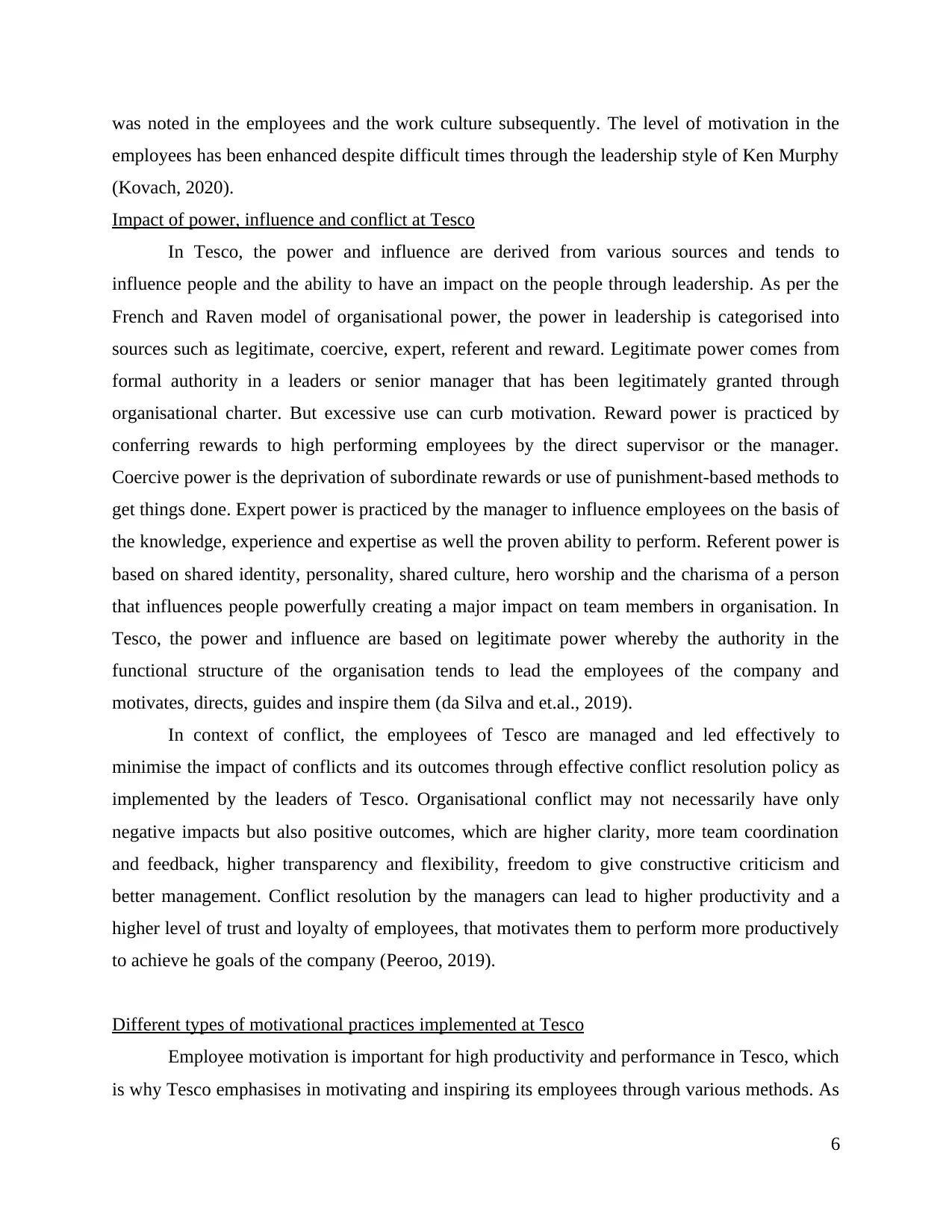
was noted in the employees and the work culture subsequently. The level of motivation in the
employees has been enhanced despite difficult times through the leadership style of Ken Murphy
(Kovach, 2020).
Impact of power, influence and conflict at Tesco
In Tesco, the power and influence are derived from various sources and tends to
influence people and the ability to have an impact on the people through leadership. As per the
French and Raven model of organisational power, the power in leadership is categorised into
sources such as legitimate, coercive, expert, referent and reward. Legitimate power comes from
formal authority in a leaders or senior manager that has been legitimately granted through
organisational charter. But excessive use can curb motivation. Reward power is practiced by
conferring rewards to high performing employees by the direct supervisor or the manager.
Coercive power is the deprivation of subordinate rewards or use of punishment-based methods to
get things done. Expert power is practiced by the manager to influence employees on the basis of
the knowledge, experience and expertise as well the proven ability to perform. Referent power is
based on shared identity, personality, shared culture, hero worship and the charisma of a person
that influences people powerfully creating a major impact on team members in organisation. In
Tesco, the power and influence are based on legitimate power whereby the authority in the
functional structure of the organisation tends to lead the employees of the company and
motivates, directs, guides and inspire them (da Silva and et.al., 2019).
In context of conflict, the employees of Tesco are managed and led effectively to
minimise the impact of conflicts and its outcomes through effective conflict resolution policy as
implemented by the leaders of Tesco. Organisational conflict may not necessarily have only
negative impacts but also positive outcomes, which are higher clarity, more team coordination
and feedback, higher transparency and flexibility, freedom to give constructive criticism and
better management. Conflict resolution by the managers can lead to higher productivity and a
higher level of trust and loyalty of employees, that motivates them to perform more productively
to achieve he goals of the company (Peeroo, 2019).
Different types of motivational practices implemented at Tesco
Employee motivation is important for high productivity and performance in Tesco, which
is why Tesco emphasises in motivating and inspiring its employees through various methods. As
6
employees has been enhanced despite difficult times through the leadership style of Ken Murphy
(Kovach, 2020).
Impact of power, influence and conflict at Tesco
In Tesco, the power and influence are derived from various sources and tends to
influence people and the ability to have an impact on the people through leadership. As per the
French and Raven model of organisational power, the power in leadership is categorised into
sources such as legitimate, coercive, expert, referent and reward. Legitimate power comes from
formal authority in a leaders or senior manager that has been legitimately granted through
organisational charter. But excessive use can curb motivation. Reward power is practiced by
conferring rewards to high performing employees by the direct supervisor or the manager.
Coercive power is the deprivation of subordinate rewards or use of punishment-based methods to
get things done. Expert power is practiced by the manager to influence employees on the basis of
the knowledge, experience and expertise as well the proven ability to perform. Referent power is
based on shared identity, personality, shared culture, hero worship and the charisma of a person
that influences people powerfully creating a major impact on team members in organisation. In
Tesco, the power and influence are based on legitimate power whereby the authority in the
functional structure of the organisation tends to lead the employees of the company and
motivates, directs, guides and inspire them (da Silva and et.al., 2019).
In context of conflict, the employees of Tesco are managed and led effectively to
minimise the impact of conflicts and its outcomes through effective conflict resolution policy as
implemented by the leaders of Tesco. Organisational conflict may not necessarily have only
negative impacts but also positive outcomes, which are higher clarity, more team coordination
and feedback, higher transparency and flexibility, freedom to give constructive criticism and
better management. Conflict resolution by the managers can lead to higher productivity and a
higher level of trust and loyalty of employees, that motivates them to perform more productively
to achieve he goals of the company (Peeroo, 2019).
Different types of motivational practices implemented at Tesco
Employee motivation is important for high productivity and performance in Tesco, which
is why Tesco emphasises in motivating and inspiring its employees through various methods. As
6

per the Hertzberg’s two factor theory of motivation, employees are motivated through primarily
two things which are motivators and hygiene factors. Motivators encourage employees to work
harder while hygiene factors may cause employees to become demotivated if not provided.
Motivators are intangible things that are needed on a daily basis. For motivators Tesco provides
various recognition opportunities and programs such as employee of the month awards and extra
parking space for top performers in respective departments. Achievement feelings are also
motivating factors which is the challenging nature of work itself which built a sense of
attainment in employees on a daily basis. The opportunities for advancement and growth in
terms of internal job promotions and transfers as well as career management and growth through
succession planning and other elements also motivate employees. In context of hygiene factors,
Tesco employs company policies that make the workplace flexible working environment and
work life balance. Supervision, training, direction and development practices also motivate
employees to utilise their skills and work harder. The working conditions also motivate
employees (Alshmemri, Shahwan-Akl and Maude, 2017). The remuneration and salary structure
of Tesco is quite competitive which helps employees to fulfil all their requirements and are apt as
per the job role. Along with a well structure compensation benefits, other fringe benefits are
given to employees such as Mediclaim and health insurance, discounts on buying from Tesco
stores, holiday packages, paid and sick leaves, retirement benefits etc. There are rewards and
recognition programs in Tesco that help in motivating employees to work competitively and
deliver high quality performance such as bonus, incentives both monetary and promotions
(Aiello and et.al., 2020).
Corporate examples and literature
Tesco uses transformational management style which is more focussed on major changes
and exceeding expected performance by the employees which is evident in Tesco. Tesco has
become the most successful organisation and retailer in Britain and around other countries across
globe. A series of organisational changes were implemented by Ken Murphy after his
appointment and making Tesco more customer focussed after developing the workforce of the
company. The CEO believes that being successful is done by maintaining a happy workforce.
There are various examples in Tesco such as crisis management plan implemented at the time of
covid-19 pandemic and changes in reward systems that are evident to the transformational
7
two things which are motivators and hygiene factors. Motivators encourage employees to work
harder while hygiene factors may cause employees to become demotivated if not provided.
Motivators are intangible things that are needed on a daily basis. For motivators Tesco provides
various recognition opportunities and programs such as employee of the month awards and extra
parking space for top performers in respective departments. Achievement feelings are also
motivating factors which is the challenging nature of work itself which built a sense of
attainment in employees on a daily basis. The opportunities for advancement and growth in
terms of internal job promotions and transfers as well as career management and growth through
succession planning and other elements also motivate employees. In context of hygiene factors,
Tesco employs company policies that make the workplace flexible working environment and
work life balance. Supervision, training, direction and development practices also motivate
employees to utilise their skills and work harder. The working conditions also motivate
employees (Alshmemri, Shahwan-Akl and Maude, 2017). The remuneration and salary structure
of Tesco is quite competitive which helps employees to fulfil all their requirements and are apt as
per the job role. Along with a well structure compensation benefits, other fringe benefits are
given to employees such as Mediclaim and health insurance, discounts on buying from Tesco
stores, holiday packages, paid and sick leaves, retirement benefits etc. There are rewards and
recognition programs in Tesco that help in motivating employees to work competitively and
deliver high quality performance such as bonus, incentives both monetary and promotions
(Aiello and et.al., 2020).
Corporate examples and literature
Tesco uses transformational management style which is more focussed on major changes
and exceeding expected performance by the employees which is evident in Tesco. Tesco has
become the most successful organisation and retailer in Britain and around other countries across
globe. A series of organisational changes were implemented by Ken Murphy after his
appointment and making Tesco more customer focussed after developing the workforce of the
company. The CEO believes that being successful is done by maintaining a happy workforce.
There are various examples in Tesco such as crisis management plan implemented at the time of
covid-19 pandemic and changes in reward systems that are evident to the transformational
7
Paraphrase This Document
Need a fresh take? Get an instant paraphrase of this document with our AI Paraphraser
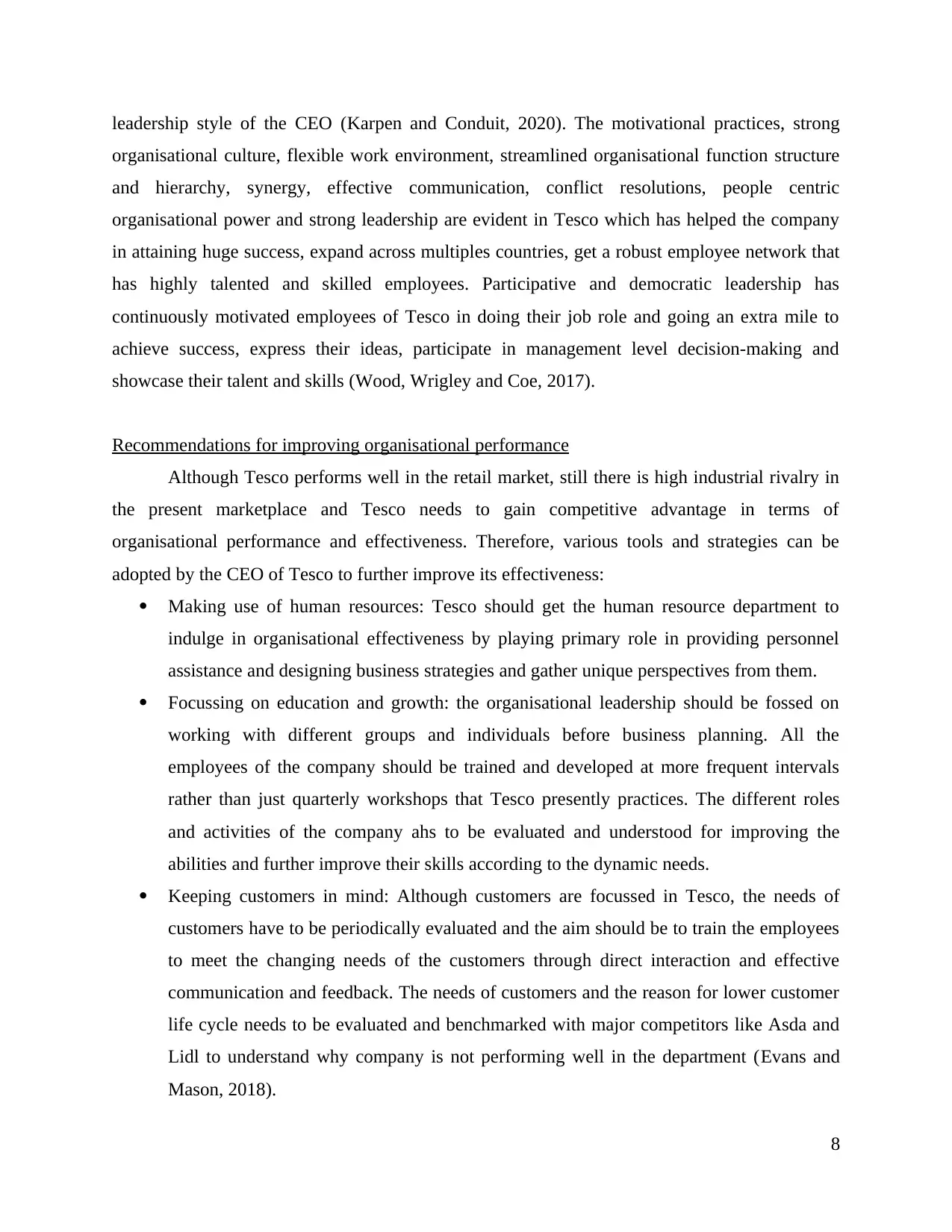
leadership style of the CEO (Karpen and Conduit, 2020). The motivational practices, strong
organisational culture, flexible work environment, streamlined organisational function structure
and hierarchy, synergy, effective communication, conflict resolutions, people centric
organisational power and strong leadership are evident in Tesco which has helped the company
in attaining huge success, expand across multiples countries, get a robust employee network that
has highly talented and skilled employees. Participative and democratic leadership has
continuously motivated employees of Tesco in doing their job role and going an extra mile to
achieve success, express their ideas, participate in management level decision-making and
showcase their talent and skills (Wood, Wrigley and Coe, 2017).
Recommendations for improving organisational performance
Although Tesco performs well in the retail market, still there is high industrial rivalry in
the present marketplace and Tesco needs to gain competitive advantage in terms of
organisational performance and effectiveness. Therefore, various tools and strategies can be
adopted by the CEO of Tesco to further improve its effectiveness:
Making use of human resources: Tesco should get the human resource department to
indulge in organisational effectiveness by playing primary role in providing personnel
assistance and designing business strategies and gather unique perspectives from them.
Focussing on education and growth: the organisational leadership should be fossed on
working with different groups and individuals before business planning. All the
employees of the company should be trained and developed at more frequent intervals
rather than just quarterly workshops that Tesco presently practices. The different roles
and activities of the company ahs to be evaluated and understood for improving the
abilities and further improve their skills according to the dynamic needs.
Keeping customers in mind: Although customers are focussed in Tesco, the needs of
customers have to be periodically evaluated and the aim should be to train the employees
to meet the changing needs of the customers through direct interaction and effective
communication and feedback. The needs of customers and the reason for lower customer
life cycle needs to be evaluated and benchmarked with major competitors like Asda and
Lidl to understand why company is not performing well in the department (Evans and
Mason, 2018).
8
organisational culture, flexible work environment, streamlined organisational function structure
and hierarchy, synergy, effective communication, conflict resolutions, people centric
organisational power and strong leadership are evident in Tesco which has helped the company
in attaining huge success, expand across multiples countries, get a robust employee network that
has highly talented and skilled employees. Participative and democratic leadership has
continuously motivated employees of Tesco in doing their job role and going an extra mile to
achieve success, express their ideas, participate in management level decision-making and
showcase their talent and skills (Wood, Wrigley and Coe, 2017).
Recommendations for improving organisational performance
Although Tesco performs well in the retail market, still there is high industrial rivalry in
the present marketplace and Tesco needs to gain competitive advantage in terms of
organisational performance and effectiveness. Therefore, various tools and strategies can be
adopted by the CEO of Tesco to further improve its effectiveness:
Making use of human resources: Tesco should get the human resource department to
indulge in organisational effectiveness by playing primary role in providing personnel
assistance and designing business strategies and gather unique perspectives from them.
Focussing on education and growth: the organisational leadership should be fossed on
working with different groups and individuals before business planning. All the
employees of the company should be trained and developed at more frequent intervals
rather than just quarterly workshops that Tesco presently practices. The different roles
and activities of the company ahs to be evaluated and understood for improving the
abilities and further improve their skills according to the dynamic needs.
Keeping customers in mind: Although customers are focussed in Tesco, the needs of
customers have to be periodically evaluated and the aim should be to train the employees
to meet the changing needs of the customers through direct interaction and effective
communication and feedback. The needs of customers and the reason for lower customer
life cycle needs to be evaluated and benchmarked with major competitors like Asda and
Lidl to understand why company is not performing well in the department (Evans and
Mason, 2018).
8
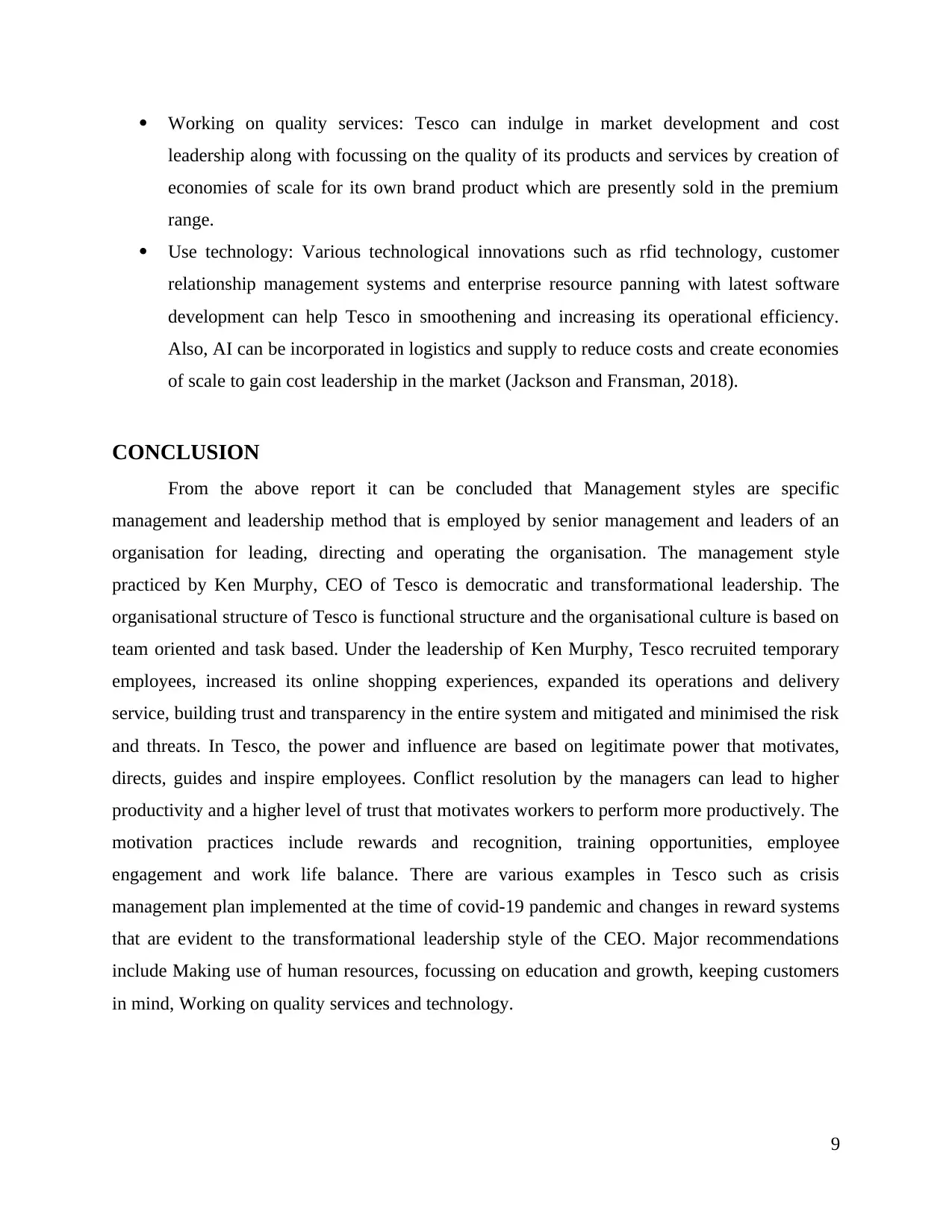
Working on quality services: Tesco can indulge in market development and cost
leadership along with focussing on the quality of its products and services by creation of
economies of scale for its own brand product which are presently sold in the premium
range.
Use technology: Various technological innovations such as rfid technology, customer
relationship management systems and enterprise resource panning with latest software
development can help Tesco in smoothening and increasing its operational efficiency.
Also, AI can be incorporated in logistics and supply to reduce costs and create economies
of scale to gain cost leadership in the market (Jackson and Fransman, 2018).
CONCLUSION
From the above report it can be concluded that Management styles are specific
management and leadership method that is employed by senior management and leaders of an
organisation for leading, directing and operating the organisation. The management style
practiced by Ken Murphy, CEO of Tesco is democratic and transformational leadership. The
organisational structure of Tesco is functional structure and the organisational culture is based on
team oriented and task based. Under the leadership of Ken Murphy, Tesco recruited temporary
employees, increased its online shopping experiences, expanded its operations and delivery
service, building trust and transparency in the entire system and mitigated and minimised the risk
and threats. In Tesco, the power and influence are based on legitimate power that motivates,
directs, guides and inspire employees. Conflict resolution by the managers can lead to higher
productivity and a higher level of trust that motivates workers to perform more productively. The
motivation practices include rewards and recognition, training opportunities, employee
engagement and work life balance. There are various examples in Tesco such as crisis
management plan implemented at the time of covid-19 pandemic and changes in reward systems
that are evident to the transformational leadership style of the CEO. Major recommendations
include Making use of human resources, focussing on education and growth, keeping customers
in mind, Working on quality services and technology.
9
leadership along with focussing on the quality of its products and services by creation of
economies of scale for its own brand product which are presently sold in the premium
range.
Use technology: Various technological innovations such as rfid technology, customer
relationship management systems and enterprise resource panning with latest software
development can help Tesco in smoothening and increasing its operational efficiency.
Also, AI can be incorporated in logistics and supply to reduce costs and create economies
of scale to gain cost leadership in the market (Jackson and Fransman, 2018).
CONCLUSION
From the above report it can be concluded that Management styles are specific
management and leadership method that is employed by senior management and leaders of an
organisation for leading, directing and operating the organisation. The management style
practiced by Ken Murphy, CEO of Tesco is democratic and transformational leadership. The
organisational structure of Tesco is functional structure and the organisational culture is based on
team oriented and task based. Under the leadership of Ken Murphy, Tesco recruited temporary
employees, increased its online shopping experiences, expanded its operations and delivery
service, building trust and transparency in the entire system and mitigated and minimised the risk
and threats. In Tesco, the power and influence are based on legitimate power that motivates,
directs, guides and inspire employees. Conflict resolution by the managers can lead to higher
productivity and a higher level of trust that motivates workers to perform more productively. The
motivation practices include rewards and recognition, training opportunities, employee
engagement and work life balance. There are various examples in Tesco such as crisis
management plan implemented at the time of covid-19 pandemic and changes in reward systems
that are evident to the transformational leadership style of the CEO. Major recommendations
include Making use of human resources, focussing on education and growth, keeping customers
in mind, Working on quality services and technology.
9

REFERENCES
Books and Journals
Aiello, L.M., and et.al., 2020. Tesco Grocery 1.0, a large-scale dataset of grocery purchases in
London. Scientific Data, 7(1), pp.1-11.
Alshmemri, M., Shahwan-Akl, L. and Maude, P., 2017. Herzberg’s two-factor theory. Life
Science Journal, 14(5), pp.12-16.
Ayub, N., and et.al., 2017. Personality traits and conflict management styles in predicting job
performance and conflict. International Journal of Conflict Management.
Buil, I., Martínez, E. and Matute, J., 2019. Transformational leadership and employee
performance: The role of identification, engagement and proactive
personality. International Journal of Hospitality Management, 77, pp.64-75.
Carvalho, A.M., and et.al., 2019. Operational excellence, organisational culture and agility: the
missing link?. Total Quality Management & Business Excellence, 30(13-14), pp.1495-
1514.
da Silva, A.W.P., and et.al., 2019. Correlations between power and affective organizational
commitment. Revista de Gestão e Secretariado, 10(1), pp.91-118.
Evans, B. and Mason, R., 2018. The lean supply chain: managing the challenge at Tesco. Kogan
Page Publishers.
Jackson, L.T. and Fransman, E.I., 2018. Flexi work, financial well-being, work-life balance and
their effects on subjective experiences of productivity and job satisfaction of females in
an institution of higher learning. South African Journal of Economic and Management
Sciences, 21(1), pp.1-13.
Jensen, M., Potočnik, K. and Chaudhry, S., 2020. A mixed-methods study of CEO
transformational leadership and firm performance. European Management Journal.
Karpen, I.O. and Conduit, J., 2020. Engaging in times of COVID-19 and beyond: theorizing
customer engagement through different paradigmatic lenses. Journal of Service
Management.
Kovach, M., 2020. Leader Influence: A Research Review of French & Raven’s (1959) Power
Dynamics. The Journal of Values-Based Leadership, 13(2), p.15.
Kraśnicka, T., Głód, W. and Wronka-Pośpiech, M., 2018. Management innovation, pro-
innovation organisational culture and enterprise performance: testing the mediation
effect. Review of Managerial Science, 12(3), pp.737-769.
Peeroo, S., 2019. Customer-initiated conversations on Facebook pages of Tesco and Walmart.
In Information Systems Design and Intelligent Applications (pp. 43-51). Springer,
Singapore.
Uddin, S.M. and Ferdous, J., 2020. Exploring the Challenges of Organizational Leadership and
Management. Journal of ELT and Education, 3(2), pp.44-50.
Wood, S., Wrigley, N. and Coe, N.M., 2017. Capital discipline and financial market relations in
retail globalization: insights from the case of Tesco plc. Journal of Economic
Geography, 17(1), pp.31-57.
Yu, S.O. ed., 2017. Art of Modern Oriental Management: Applying the Chinese, Japanese and
Korean Management Styles at Work. World Scientific.
10
Books and Journals
Aiello, L.M., and et.al., 2020. Tesco Grocery 1.0, a large-scale dataset of grocery purchases in
London. Scientific Data, 7(1), pp.1-11.
Alshmemri, M., Shahwan-Akl, L. and Maude, P., 2017. Herzberg’s two-factor theory. Life
Science Journal, 14(5), pp.12-16.
Ayub, N., and et.al., 2017. Personality traits and conflict management styles in predicting job
performance and conflict. International Journal of Conflict Management.
Buil, I., Martínez, E. and Matute, J., 2019. Transformational leadership and employee
performance: The role of identification, engagement and proactive
personality. International Journal of Hospitality Management, 77, pp.64-75.
Carvalho, A.M., and et.al., 2019. Operational excellence, organisational culture and agility: the
missing link?. Total Quality Management & Business Excellence, 30(13-14), pp.1495-
1514.
da Silva, A.W.P., and et.al., 2019. Correlations between power and affective organizational
commitment. Revista de Gestão e Secretariado, 10(1), pp.91-118.
Evans, B. and Mason, R., 2018. The lean supply chain: managing the challenge at Tesco. Kogan
Page Publishers.
Jackson, L.T. and Fransman, E.I., 2018. Flexi work, financial well-being, work-life balance and
their effects on subjective experiences of productivity and job satisfaction of females in
an institution of higher learning. South African Journal of Economic and Management
Sciences, 21(1), pp.1-13.
Jensen, M., Potočnik, K. and Chaudhry, S., 2020. A mixed-methods study of CEO
transformational leadership and firm performance. European Management Journal.
Karpen, I.O. and Conduit, J., 2020. Engaging in times of COVID-19 and beyond: theorizing
customer engagement through different paradigmatic lenses. Journal of Service
Management.
Kovach, M., 2020. Leader Influence: A Research Review of French & Raven’s (1959) Power
Dynamics. The Journal of Values-Based Leadership, 13(2), p.15.
Kraśnicka, T., Głód, W. and Wronka-Pośpiech, M., 2018. Management innovation, pro-
innovation organisational culture and enterprise performance: testing the mediation
effect. Review of Managerial Science, 12(3), pp.737-769.
Peeroo, S., 2019. Customer-initiated conversations on Facebook pages of Tesco and Walmart.
In Information Systems Design and Intelligent Applications (pp. 43-51). Springer,
Singapore.
Uddin, S.M. and Ferdous, J., 2020. Exploring the Challenges of Organizational Leadership and
Management. Journal of ELT and Education, 3(2), pp.44-50.
Wood, S., Wrigley, N. and Coe, N.M., 2017. Capital discipline and financial market relations in
retail globalization: insights from the case of Tesco plc. Journal of Economic
Geography, 17(1), pp.31-57.
Yu, S.O. ed., 2017. Art of Modern Oriental Management: Applying the Chinese, Japanese and
Korean Management Styles at Work. World Scientific.
10
1 out of 10
Related Documents
Your All-in-One AI-Powered Toolkit for Academic Success.
+13062052269
info@desklib.com
Available 24*7 on WhatsApp / Email
![[object Object]](/_next/static/media/star-bottom.7253800d.svg)
Unlock your academic potential
© 2024 | Zucol Services PVT LTD | All rights reserved.





